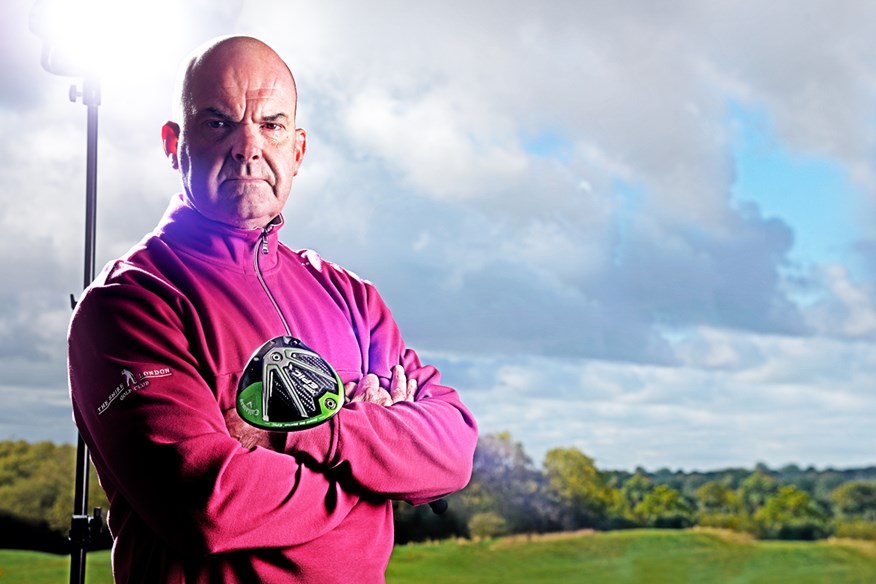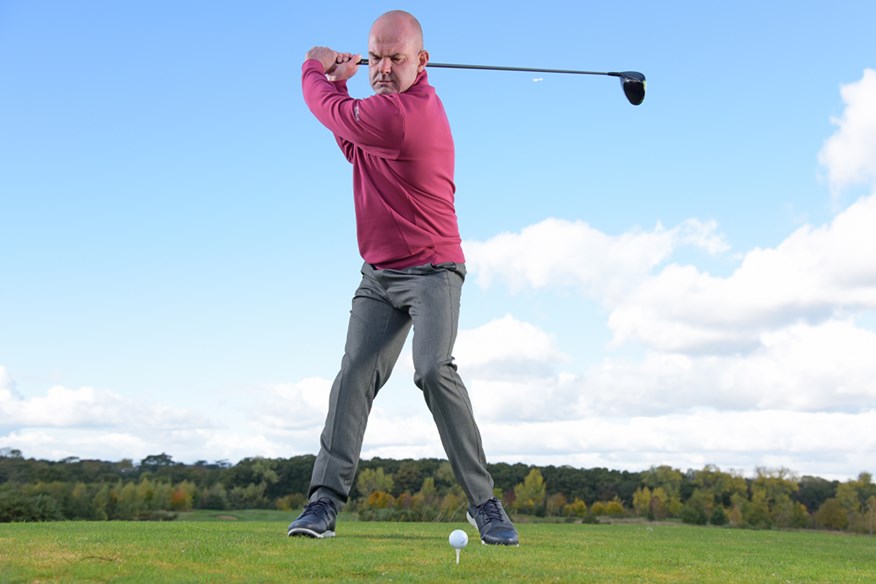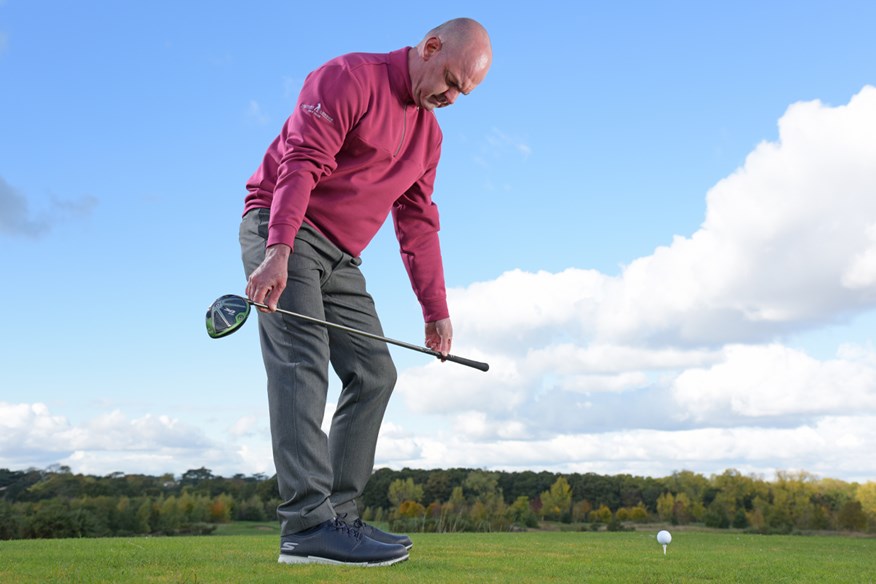I gained 8mph and 24 yards after one golf lesson with this unique coach
Last updated:
Learn the secrets of a faster swing and longer drives from the world’s leading long drive coach.
Every golfer wants to drive the ball further. Confidently striding past your playing partner’s tee shot, knowing your ball is the one 30 yards further up, is one of the most satisfying feelings in the game.
But extra yards are good for more than just your ego. “Distance is far more of an indicator of success than accuracy,” says Sean Foley, who has coached Tiger Woods, Lee Westwood, and Justin Rose, amongst others. “If I have the choice of giving someone five extra miles per hour in clubhead speed or have him hit the corresponding amount of more fairways, net earnings will increase more from the extra swing speed.”
He’s right. The straightest drivers on tour lag well behind the longest hitters when it comes to tour wins and earnings.

Cameron Champ led the PGA Tour in ‘Strokes Gained: Off-the-tee’ for the 2024 season. He ranked 1st for driving distance and… 125th for driving accuracy.
And the importance of distance isn’t limited to tour pros. Analysis by Hunt Golf Analytics found that a 5mph increase in swing speed correlates to a 3.6-shot drop in handicap.
Reading this, you’re probably itching to add yards to your drives.
Whether you’re struggling to get your drives 150 yards or eyeing a career on the World Long Drive circuit, one man has become the go-to guru for distance.
That man is Lee Cox. He coached Joe Miller to two World Long Drive Championships, James Tait to his first win in the World Long Drive Series, and guided Mike Gays to a World Para Long Drive Championship.
Cox is the man the game’s biggest hitters enlist to help them hit it further, but he’s equally adept at working with amateurs, particularly as there is typically more room for improvement with someone swinging at 90mph than a supreme athlete who already generates 150mph or more.
A few years ago, I went to see him at his studio at The Shire in Barnet, hoping he could turn me into the kind of guy who draws gasps at the driving range, or at least help me reach a few more par 5s in two. I’ll tell you what happened during that one-hour lesson – and update you on how things are going now.

My golf lesson with long drive coach Lee Cox
The first thing I realised is that Lee Cox isn’t like most golf coaches. There’s no false praise, no encouraging platitudes. If he doesn’t like what he sees, he tells you, and in no uncertain terms.
“You’ve heard of fake news, yeah? Well you’ve got a fake turn,” he snarls, as I try with all my might to add an extra mile an hour to my depressingly average swing speed. “Is that all you’ve got?” he spits, as another of my drives plops down way short of a range fence that some of his students clear with ease. He wouldn’t seem out of place at an East End boxing gym. Where a standard running coach might help you run faster, Cox is a chasing pit bull. He makes you swing faster. Forces you to hit it further.
That’s not to say it’s all brute force and intimidation. Cox knows his biomechanics from his centripetal acceleration, his aerodynamics from his spin vectors. He’s spent 30 years studying the swing, staying on top of innovations and developments to build a wealth of knowledge that enables him to keep it simple for students.
“I’ve always started with ball speed,” he says. “Ball speed is king, because that is what determines how far you can hit it. Most people who come in don’t hit the ball well enough to get the most out of what they have, which means they are leaving yards on the table, without even having to worry about increasing their swing speed.”
Cox calls these inefficiencies “power leaks” and says every golfer has them. “A lot of people I see can gain a lot of ball speed and distance without adding any swing speed. Eradicating glancing blows is a big factor. Is your face-to-path good? What about your angle of attack to dynamic loft? Are you hitting the middle of the face?”
Cox tells me, encouragingly, that I am “actually quite optimal” and getting quite a lot out of my speed. That’s the good news.
The bad news is that my swing speed isn’t even close to what I thought. I’ve been on countless launch monitors and clocked 100mph with ease, even seeing a glorious 107mph once.
“A lot of people come in and they’ve been to American Golf or wherever, and they say, ‘My swing speed is 116mph’,” says Cox. “I’m thinking, ‘Wow, he’s as fast as Brooks Koepka here’. Then they swing and it’s nowhere near that. I’ll point to my FlightScope and ask if they know what it is. They’ll say, ‘Yeah, it’s a launch monitor’. I say, ‘No, it’s a lie detector’. People don’t always like the truth, but it’s vital we have data. If you’re not measuring, you’re guessing. If you don’t have all the numbers, you can’t tell what needs to improve and you can’t measure improvement.”
My truth is a swing speed of 95mph. “The average for a male is 93mph,” Cox tells me, my spirits lifting slightly. “But that includes 70-year-old blokes,” he concludes, as my spirits dive again.
Cox uses slow motion video and FlightScope to see exactly what is going on in my swing, and then sets about turning me into a power-hitting behemoth.
“People think you’re either blessed as a fast swinger or you’re not,” he says. “That’s wrong. Swinging fast is a skill and it can be worked at. I’ve never met anyone I can’t make go faster. Whether they’re 15 or 70, I’ve always got something out of them. I can give most people an extra 10mph.”
Cox gets me making fresh-air swings with a light stick. I’m able to clock 115mph. He then hands me my driver and tells me to make the same swing. The radar says 103mph. “Got any more?” he asks – nay, demands. 107mph. “What I’m trying to see is whether you already have a faster swing that you don’t use,” he says. “You’re a decent player, so you automatically downgrade your speed because you’re focused on hitting fairways.” I make a few more of these swings, registering 108 and then 106mph. “I don’t care where this goes,” says Cox, teeing up a ball. “I don’t care whether it stays on the planet. I don’t care. Just smash it to death.” I swing out of my boots, miraculously make contact, and register 99mph. “So, it’s a jump. I reckon you’ve got 100 in you,” says Cox. I hit another. The radar says 103mph.

“Where did that go?” I pant. “Oh, it was off the planet. The whole point isn’t that you’re going to play like this. It’s how you’re going to build speed.”
Cox believes that every golfer could increase their swing speed, they just never try. “Every golfer has a maximum speed they can generate when they are swinging completely flat out,” he says. “Their normal, on-the-golf-course swing, will be about 92% as fast. You need to increase your 100% number. As that goes up, the 92% number gets dragged up with it. People don’t practise swinging fast because they think, ‘What’s the point smashing the hell out of it? I can’t play golf like that’. But you build the top number and your standard swing gets faster. People just can’t get their brains around that.”
Cox’s approach is simple. Go to the range more. Hit more drivers. Make practice swings as fast as you can. Hit balls as fast as you can, not worrying about where they go. Hit a headcover or something similar as hard as you can.
It’s based on overspeed training, a principle Cox says is widely used in other speed sports. “Sprinters practise running downhill because it means they can run the 100 metres in nine seconds. It gets your body used to going faster than normal. That’s how to increase your normal speed.”
Cox makes some technical adjustments to my swing and gets my practice swings registering at more than 110mph before reintroducing a ball. I hit drives at 105-107mph. They wouldn’t exactly set up birdie chances on the course – finding them would be a miracle – but Cox reminds me that’s not the point. “You’re at 107 now, so when you play you’ll be swinging at 100.”
He gets me to hit some normal drives, as if I’m trying to hit a fairway on the golf course. They all register over 100mph. “You can play well at 100. You can’t play well at 107, but if you keep working on things, you could take your maximum speed to 116 and then your ‘normal’ swing would be 107, and you’d be able to play well with that.”
Given that each mile an hour equates to three yards in distance, it’s not hard to see how adding five or even 12mph to my standard swing would make a big difference to my game. “I can give most people a minimum increase of 10mph,” says Cox.
By the end of the session, I’m hitting balls flat-out at 110mph and making normal swings at 103mph, which adds more than 20 yards to my driving distance from the start of the session. If a new £500 driver offered me that, I’d buy two. Cox managed it in a one-hour session, which cost £62. That’s why he’s the king of distance.

The update – how are the results now?
I’d love to tell you that I’ve followed Lee Cox’s swing speed protocol religiously for the last few years and now make Bryson DeChambeau look like a short hitter. Sadly, that isn’t the case, and there is one main reason for that.
Driving has pretty much always been the strongest part of my game. I don’t struggle for distance and I tend to keep it in play, which shot-tracking devices like ShotScope have previously told me means I gain strokes against a scratch golfer. I therefore tend to use any practice time I have to work on my weaknesses, aka pretty much every other part of the game. I know the stats say that more distance would help my scores, and I don’t doubt that, but I think I’ve got more to gain by working on the things that are really costing me shots out on the course.
That said, I have implemented some of Lee’s ideas and I think it’s no coincidence that I hit it as far now as I ever have, despite now being in my forties.
In the winter, when outdoor practice isn’t always appealing or even possible, I’ll sometimes make use of a shed at my golf club that has two nets inside. Hitting balls into a net with no launch monitor obviously doesn’t give any feedback on shot shape etc, which makes ‘normal’ practice unfulfilling, so I’ll often hit some drivers flat-out as per Lee Cox’s recommendations. I think that doing so has helped maintain and increase my swing speed even as I get older.
Four steps to longer drives
Lee Cox shares his four top tips to boost swing speed and driving distance.

1. Lift your lead heel
“Most of the long drive boys lift their left heel. Francesco Molinari has added 30 yards off the tee since he started doing it, too. It allows your hips to turn more, which is a major power source. It also helps the sequencing of your entire swing.
“Power hitters slam back into the space they’ve created under their left heel to start the downswing. Even a 20-year-old tour player who doesn’t lift their heel will have almost no pressure under it at the top of their swing. Lift your heel in the takeaway and then slam it down to start your downswing; it causes your left hip to move away and rotate open, which is a huge source of speed.”

2. Hit headcovers
“When you’re training for speed, it’s important to have some resistance. People can make fresh air swings at great speed but, as soon as you put an object there for them to hit, their speed goes back to normal. To overcome this, practise hitting an old headcover as hard as you can. This focuses you on generating maximum speed and bringing your forces together at the point that matters most – impact.
“Do this with just your left arm, just your right arm, and then both together. Start with one headcover and then, as you get better, add an extra one, two or three. This builds the resistance, continuing to increase your speed and power.”

3. Turn and stamp
“Set up normally, then lift your left foot and bring it across your body as far as you can. This allows you to load the pressure into your right leg, stabilise it, and turn your pelvis more. These things all increase your potential for power. Start your downswing by stamping your left foot down and applying maximum pressure into it.
“One of the biggest reasons amateurs don’t hit the ball very far is they don’t get anywhere near enough weight onto their left side early enough in their swing. Your pressure should be completely into your left foot by the time your left arm reaches horizontal on the downswing.”

4. Let your legs work
“People are very frightened of any hip movement. They don’t like to let their hips and legs move. They’ve got the idea that resisting leg movement and turning against that is going to create speed, but that’s not the case. If you go back to the 1990s, a lot of coaches were teaching people to swing with a beach ball between their legs to reduce leg action. You can hit straight shots like that, but you can’t hit it very far.
“Hold a club across your legs and rehearse a movement that lets it turn as far as you can. Let your knees move and change direction. Your left leg flexes more and your right leg straightens; this allows pelvic movement, which generates power.”
Still want more distance?
-
 Switching golf ball can add distance to your drives
Switching golf ball can add distance to your drives
-
 Lee Cox wasn't impressed by my "fake turn".
Lee Cox wasn't impressed by my "fake turn".
-
 Most golfers are wary of hitting balls as hard as they can, but it's a great way to increase your swing speed.
Most golfers are wary of hitting balls as hard as they can, but it's a great way to increase your swing speed.
-
 Hitting headcovers can help improve your swing speed and driving distance.
Hitting headcovers can help improve your swing speed and driving distance.
-
 Lee Cox is the world's leading long drive golf coach.
Lee Cox is the world's leading long drive golf coach.
-
 Learning to transfer pressure is key to a powerful golf swing.
Learning to transfer pressure is key to a powerful golf swing.
-
 Learning the correct leg action in the golf swing will help you generate more speed and power, leading to longer drives.
Learning the correct leg action in the golf swing will help you generate more speed and power, leading to longer drives.
-
 Lifting your lead heel in the backswing can help you generate more power in your golf swing.
Lifting your lead heel in the backswing can help you generate more power in your golf swing.
